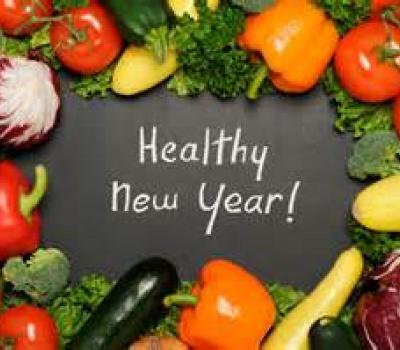All tags
5 star recipes
A
air fry
alcohol beverages
Beverages
BREADS
Breakfast
cakes
Candy
Casseroles
charcuterie boards
Chicken
chili
Chinese
Chowder
Christmas
coffee cakes
Conversion Chart
cookies
dale.
DESSERTS
DIPS
easter
fish
Freezer Meals
Friends
Halloween
herbs/spices
jan's canning
jan's ice cream
meat
Mexican
MISC
Muffins
new years
pasta
Pastry
Pies
polish
Potatoes
potpourri
pressure canner
QUICK BREADS
Rice
Salad Dressings
SALADS
sandwich spreads
Sandwiches
Seafood
Skillet
SNACKS
Soup
st. patrick
Stews
summer
t
Thanksgiving
Vegetables

Healthy New Year's Resolutions NEW YEARS
Ingredients
You know the drill — a new year starts and you feel compelled to make a resolution. "No more bread!" "I will lose weight." "I'm going to get healthy." But as you've probably heard experts say, goals don't work unless they're measurable and time-oriented. So forget the broad strokes and go for one (or all) of these specific healthy resolutions you can actually stick to.Instructions
Swap one beverage a day for waterIf you're a soda (or even diet soda) junkie, start small by swapping out one sugary (or artificially sweet) beverage for a glass of water every day. If you're not a fan of plain water, jazz it up with lemon or cucumber slices or try a flavored seltzer. Even unsweetened tea or coffee is a better alternative to soda and energy drinks (just mind your caffeine intake if you're sensitive).
Have a fruit or vegetable at every meal
Ultimately you are shooting for your meals to be composed largely of fruits and vegetables, but for now just get conscious of having them on your plate at all. Like toast in the morning? Top it with fruit. Snack on sliced veggies and dip, fruit and yogurt or trail mix. Load your sandwich at lunch with some extra vegetables and don't forget to have them at dinner too.
Experts recommend eating fish at least twice a week. After all, it's good for your heart, brain, eyes and even your mood. Plan a weekly dinner with fresh fish or seafood and stock up on canned salmon and light tuna for a quick salad topper or sandwich filler.
It's one of the dietary guidelines for a reason: Whole grains offer more filling, heart-healthy fiber and nutrients than refined grains. Start by reading the labels of the bread you commonly buy. If the first ingredient isn't "whole wheat" or another "whole" grain, shop around for a new favorite. Plus, try cooking new-to-you whole grains like quinoa, barley or farro for an alternative to rice.
Do you buy a lot of products with added sugars? Not sure? Get acquainted with what's in your cupboards. Read the ingredient lists of the processed foods you eat regularly and see which ones have a lot of added sugars (in addition to sugar, it'll appear as fruit juice concentrate, honey, fructose, corn syrup, sucrose, maltodextrin and a slew of other terms).
Cooking more is one of the single best ways you can improve your diet. When you cook, you control exactly what goes into — and doesn't go into — your food. This goal is vague, but figure out what it means for you. If you already cook dinner every night, but buy your lunch, start bringing a brown bag to work. Do you rely on convenience foods a bit too often? Make a big batch of something like soup or lasagna that you can stick in the freezer for easy reheating at a moment's notice. Love the stir-fries at your local Chinese take-out? Find a recipe to make it at home.
There are a lot of health benefits to maintaining a vegetarian diet, including lowering one's risk for heart disease and some cancers. But you don't need to go whole (vegan) hog to get some of the benefits. Simply eating more vegetarian meals could help you to lower some of the saturated fat in your diet (which is linked to high cholesterol). So commit to planning one more vegetarian meal each week, using beans, tofu, tempeh or even eggs to replace meat or poultry.
my notes